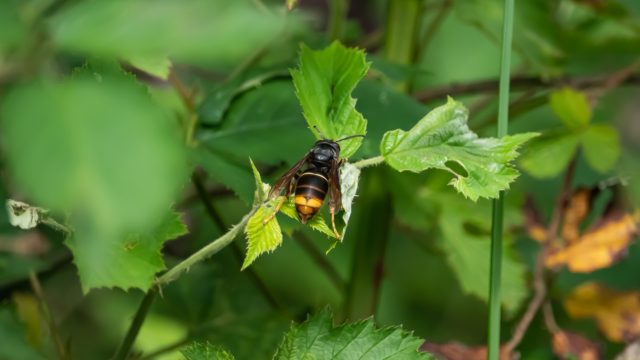30
Aug
Management of New Insect Pests Presents Safety Challenge for People and Environment: Yellow-Legged Hornets

(Beyond Pesticides, August 30, 2023) Invasive yellow-legged hornets have been spotted near Savannah, Georgia, causing concern among agriculture officials. These hornets are known for their ability to prey on honeybees and other pollinators, and their presence in the United States is a cause for alarm. This is the first time a live specimen of this species has been detected in the open United States, according to the Georgia Department of Agriculture.
The hornets, which are native to Southeast Asia, have been spotted in other parts of the world, including Europe, where they have caused significant damage to bee populations. They are considered “invasive,” which means the hornet is not native and officials expect their introduction to result in economic, environmental, or health-related damage to humans, animals, plants, or the environment. In response to the sighting in Georgia, officials are taking action to eradicate the hornets before they can cause any harm to US agriculture.
One of the methods being used to eradicate the hornets is the localized use of the highly toxic insecticide cypermethrin on nests. The pesticide has been registered for use in agriculture and residential pest control since the 1970s. It kills insects such as mosquitoes, flies, ticks, and agricultural pests like boll weevils and bollworms. The Incident Data System published over 1,400 reports of harm caused by pesticides containing cypermethrin. The chemical has been classified as a Class C possible human carcinogen, and there is evidence that it can cause a range of health problems in humans, including skin irritation, respiratory problems, and neurological effects.
Cypermethrin belongs to the class of pesticides known as pyrethroids, which is gaining popularity despite raising concerns. A preponderance of the evidence shows that pyrethroids, such as cypermethrin, pose several concerning risks to human health. A 2014 study conducted by the University of California, Davis, revealed that homes with detectable levels of pyrethroids in floor wipe tests were associated with elevated levels of pyrethroids in urine. This suggests that exposure to these chemicals occurs within the household environment and enters the human body. The study included both adults and children in California communities, with 63% of participants having detectable pyrethroid levels in their urine.
The presence of pyrethroids in the body has been linked to adverse health effects. A 2013 Canadian study found a correlation between the use of pesticides in or around homes and higher scores on emotional difficulties and conduct problems tests in children. This was further supported by a French study, which strengthened the connection between childhood behavioral disorders and pyrethroid pesticide exposure.
Another significant concern is the impact on early childhood development. A 2017 study demonstrated that higher urinary metabolite levels of cypermethrin, a specific pyrethroid, were associated with an earlier onset of puberty in boys. This suggests that pyrethroid exposure might disrupt normal hormonal development, potentially leading to developmental issues. Additionally, the use of pyrethroids has been associated with an increased risk of cancer. A 2013 study found that termite applications of pyrethroids within a year of pregnancy doubled the risk of a child developing a brain tumor.
The persistence of pyrethroids within the home environment contributes to the high frequency of detections in the general population. Since these chemicals break down slowly, even a single application can remain present for an extended period. A 2019 study applied a pyrethroid in a test home and measured the concentration at 89.6% of the original concentration after 112 days after the application of the pesticide. Subsequent applications contribute to the accumulation of pyrethroids in the household. This persistence is particularly concerning for young children, who are more susceptible to exposure due to activities such as crawling and hand-to-mouth behaviors.
Beyond Pesticides Executive Director Jay Feldman commented, “Removal of opportunist colonizers, like the yellow-legged hornet, may be necessary based on an ecological assessment and an evaluation of the options to ensure a long-term solution compatible with environmental health, but we quickly need to develop biological tools, utilize traps, and adopt cultural practices, rather than rely on the use of toxic chemicals like cypermethrin.”
The discovery of the yellow-legged hornets in Georgia is a reminder of the importance of understanding the toxic chemicals, like cypermethrin, that are used to control unwanted and invasive species. Agriculture officials are urging the public to report any sightings of the hornets to help prevent their spread. In Georgia, you can email [email protected] or submit this form. In Florida, you can email [email protected] or call the Florida hotline 1-888-397-1517.
For almost every pest issue faced today, there exist effective alternatives to synthetic insecticides such as pyrethroids. The ManageSafe tool by Beyond Pesticides offers a comprehensive, step-by-step manual to assist individuals in pest management, covering various pests ranging from cockroaches and bed bugs to head lice and ants. To learn more about the balance between managing invasive species and the risks of using toxic pesticides read Meeting the Invasive Species Challenge.
All unattributed positions and opinions in this piece are those of Beyond Pesticides.
Source: An invasive hornet that hunts honeybees is spotted in the U.S. for the first time, Chemical Watch Factsheet: Cypermethrin, Meeting the “Invasive Species” Challenge










